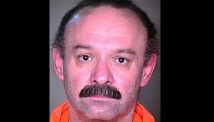Another botched execution? Inmate gasps during two-hour execution
updated 10:29 PM EDT, Wed July 23, 2014
Source: KTVK
CNN's original series "Death Row Stories" explores America's capital punishment system at 10 p.m. ET/PT Sundays on CNN. Join the conversation about the death penalty at facebook.com/cnn or Twitter @CNNorigSeries using #DeathRowStories.
"It took Joseph Wood two hours to die, and he gasped and struggled to breathe for about an hour and 40 minutes. We will renew our efforts to get information about the manufacturer of drugs as well as how Arizona came up with the experimental formula of drugs it used today," attorney Dale Baich said in a statement.
He added: "Arizona appears to have joined several other states who have been responsible for an entirely preventable horror -- a bungled execution."
Arizona Gov. Jan Brewer had directed the Department of Corrections to review the process, saying she is concerned by the length of time it took to carry out the lethal injection.
A federal judge ordered local officials to preserve all physical evidence in Wood's execution.

Inmate Joseph Wood has been executed in Arizona.
 Lethal Injection: The process
Lethal Injection: The process
"One thing is certain, however, inmate Wood died in a lawful manner and by eyewitness and medical accounts he did not suffer. This is in stark comparison to the gruesome, vicious suffering that he inflicted on his two victims -- and the lifetime of suffering he has caused their family," Brewer said.
Arizona's corrections department said in a statement that it followed protocol in Wood's execution, re-affirming his "deep sedation" seven times before he was pronounced dead.
Aside from snoring, he did not make grimaces or otherwise move, the corrections department said.
Wood was convicted of murder and assault in the 1989 deaths of his estranged girlfriend and her father.
"I don't believe he was gasping for air; I don't believe he was suffering. It sounded to me like was snoring," said Jeanne Brown, a relative of Wood's victims.
"You don't know what excruciating is. What's excruciating is seeing your dad laying there in a pool of blood, seeing you sister laying there in a pool of blood. This man deserved it. And I shouldn't really call him a man," she said.
The execution procedure began at 1:52 p.m. (4:52 p.m. ET) and concluded, with Wood's being pronounced dead, at 3:49 p.m. (6:49 p.m. ET).
Troy Hayden, a media witness from KSAZ, told reporters the execution was difficult to watch. He likened Wood's breathing to a "fish gulping for air."
"It was tough for everybody in that room," he said.
Michael Kiefer, a reporter for The Arizona Republic, has witnessed five executions, including Wood's.
"Usually it takes about 10 minutes, the person goes to sleep. This was not that," he told reporters afterward. "It started off looking as if it was going alright but then obviously something didn't go right. It took two hours."
Kiefer described the sound Wood made as a "deep, snoring, sucking air sound."
Wood's attorneys had filed an emergency motion for a stay after his execution began, saying then that Wood had been "gasping and snorting for more than an hour."
The motion read: "He is still alive. This execution has violated Mr. Wood's Eighth Amendment right to be executed in the absence of cruel and unusual punishment. We respectfully request that this Court stop the execution and require that the Department of Corrections use the lifesaving provisions required in its protocol."
Inmate objected to drugs
Earlier, the Arizona Supreme Court lifted its brief stay of the murderer's execution.
Wood was first set to be executed at 10 a.m. local time (1 p.m. ET), though it was temporarily halted when the court said it would consider his request for the justices to review his claims.
The court lifted the stay shortly after that, saying without explanation that it considered the request but decided not to review Wood's case.
Wood was the latest American death row inmate to argue that an anesthetic recently introduced in some states' execution protocols could fail to sufficiently knock out the inmate ahead of the lethal drugs, subjecting the person to an agonizing death.
Wood claimed among other things that the state was going to use an "experimental" drug protocol of midazolam and hydromorphone.
In documents filed with the state Supreme Court, he contended the use of the anesthetic midazolam was problematic in recent U.S. executions and that it would violate the Constitution's guarantee against cruel and unusual punishment.
Wood was "very concerned they were experimenting," said attorney Baich, who witnessed the execution.
"The room was silent. I was focusing on Mr. Wood. There were seven announcements during the process that Mr. Wood was still sedated. This is -- to confirm that he was still sedated.
"He was still breathing and struggling to breathe and gasping and snorting. I have witnessed 10 executions, and I had never seen that before," Baich told CNN.
No comments:
Post a Comment